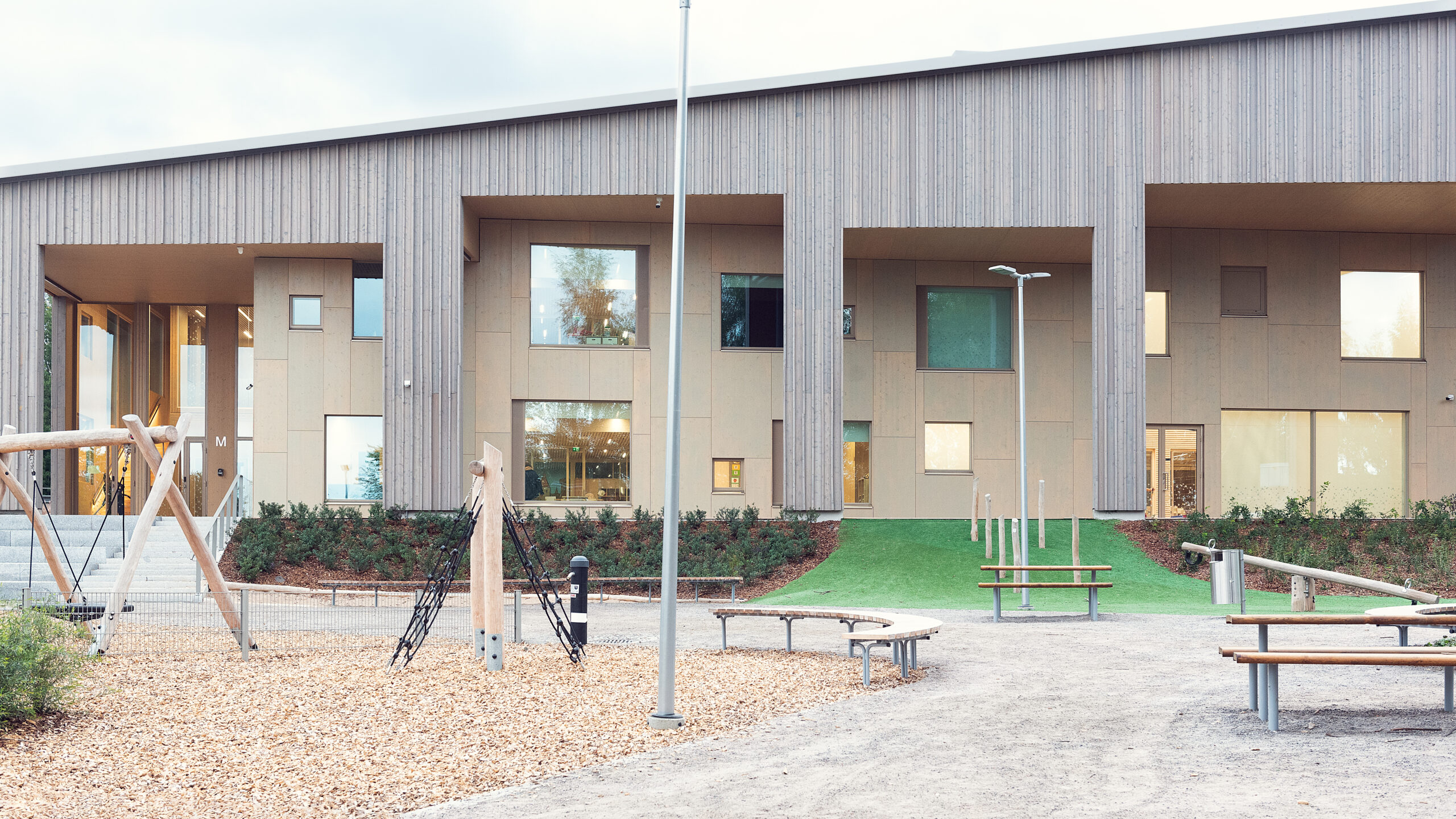The winner of Finlandia Prize 2023
Martta Wendelin Day Care Centre
The day-care centre is an excellent example of how the transition towards a more carbon neutral built environment can be achieved.
The winner of Finlandia Prize 2023
The day-care centre is an excellent example of how the transition towards a more carbon neutral built environment can be achieved.
AFKS Arkkitehdit: Jari Frondelius (lead designer), Jaakko Keppo, Juha Salmenperä, Tommi Kantanen (project architect), Mikko Liski (project architect)
Tuusula municipality
Arkta Rakennuskultti Oy
Tuusula
3,252 sqm
2022
Partners: Jari Frondelius SAFA (lead designer), Jaakko Keppo SAFA, Juha Salmenperä SAFA
Project architects: Mikko Liski SAFA, Tommi Kantinen SAFA
Interior design: interior architect SIO, Kai van der Puij SAFA
Landscape architecture: Soile Heikkinen SAFA
Structural design: Ideastructura Oy, Antti Nurmi, Samuli Maja
Acoustic design: A-Insinöörit Oy
HVAC design: Rejlers Finland Oy / Juha-Pekka Kokko, Pasi Tauru, Jarkko Bergqvist, Mirja Lehtonen
Electrical design: Reijlers Finland Oy
Fire safety systems: KK-Palokonsultti / Teemu Karhula
Consultant for carbon footprint: Granlund Oy
Specialist for wood structures: Wood Expert Oy, / Janne Manninen
Principal contractor: Arkta Rakennuskultti Oy Pasi Porento, Juha Nikkanen
Wood elements: Stora Enso (CLT), Versowood Oy (liimapuu)
Delivery of the wooden frame: Puurakentajat Group Oy

Hannu Rytky

Hannu Rytky
Completed in 2022, Martta Wendelin Day Care Centre is a wooden building designed to provide facilities for around 200 children. The interiors are oriented to the south to make the most of the wooded setting and abundance of natural light. A handsome canopy structure creates a setting for outdoor play. The spatial arrangements are carefully thought through and reflect the importance of small group spaces in providing safe and nurturing environment for the young building users. Cross-laminated timber has been chosen for the external and internal walls as well as all intermediate walls and serves as a carbon sink for the building. The day-care centre is an excellent example of how the transition towards a more carbon neutral built environment can be achieved.

Hannu Rytky
Completed in 2022, the Martta Wendelin Day Care Centre is a wooden building designed to provide capacity for around 200 children. Its location has been skillfully chosen to account for the noise and pollution emanating from the busy Tuusulanväylä motorway nearby. The interiors are oriented to the south, making the most of the wooded setting and abundance of natural light. A handsome canopy structure creates a setting for outdoor play, come rain or shine. While offering a sweep of clean lines externally, internally the day care centre is expertly designed to a child-friendly scale. The spatial arrangements are carefully thought through and reflect the importance of small group spaces in providing safe and nurturing environment for the young building users. Between these small group spaces and housed in the central frame, lies a flexible, open-plan, multi-use area comprising a series of spaces that lend themselves for additional uses outside of the day-care centre’s opening hours.
What distinguishes the Martta Wendelin Day Care Centre from other similar projects recently completed in Finland is the high-specification wood architecture and the detailed finishes that define it. The day-care centre has already garnered international recognition in the form of a wood architecture prize awarded by five European architectural journals that aims to promote and celebrate leading practitioners in this specialist field. In its remarks, the jury highlighted the way the designers have made use of CLT panelling not only for structural purposes but also to shape the building’s milieu. In a day care centre, acoustics matter and here, thanks to the materials chosen for the interiors, they are excellent.
The key priorities for the client, the municipality of Tuusula, were safety, reliable structural performance and a long life cycle. In keeping with these priorities, cross-laminated timber was chosen for the external and internal walls as well as all intermediate walls, with the material serving as a carbon sink for the building. Timber has been used for the interiors too and can be seen and felt throughout. Notably, the building has been created to accommodate future adaptation. Thanks to a design that allows new openings to be added to the loadbearing internal walls, it will be possible to reconfigure the interior spaces at a later date. The building material chosen by the client also facilitates this. Externally, the cladding consists of vertically installed and highly weather-resistant, stained larch battens in varying widths.
The Martta Wendelin Day Care Centre has also been awarded the Nordic Swan Ecolabel which recognises energy efficiency, indoor air quality and the recycling and reuse of building components. It is an excellent example of the kind of methods and interventions already available that can be implemented within the construction sector to promote sustainability and carbon neutrality, while creating architecture for the future.